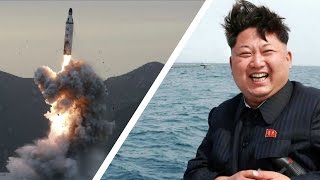Washington, Apr 20: North Korean propaganda is many things, but it's not subtle.
 Case in point: a new video, unveiled at a recent musical performance in honor of Kim II Sung, shows missiles leaving a U.S. city in flames. In the footage, a handful of missiles arc over the Pacific, then explode into a giant fireball. It ends with a burning American flag, superimposed over a cemetery of white crosses.
Case in point: a new video, unveiled at a recent musical performance in honor of Kim II Sung, shows missiles leaving a U.S. city in flames. In the footage, a handful of missiles arc over the Pacific, then explode into a giant fireball. It ends with a burning American flag, superimposed over a cemetery of white crosses.
"When the performance was over, all the performers and participants in the military parade broke into enthusiastic cheers of 'hurrah!' " the state-run KCNA news agency reported. Kim Jong Un smiled and waved afterward.
The clip was shown during a performance by North Korea's "state merited chorus" Sunday. Their concert included songs with such lyrics as "our proud Hwasong rocket blasts off" and "flies as quickly as a flash of lightning to challenge imperialism," according to South Korean newswire Yonhap.
It's not the first time North Korea has offered up a simulated tale of American destruction. In 2016, the country released a video called "Last Chance." It depicted a nuclear strike on Washington, complete with a missile demolishing the Lincoln Memorial. The four-minute video also featured a 1960s Western-style score and a mushroom cloud over the U.S. capital. Oh, and of course - an American flag on fire.
In 2013, a simulated video showed nuclear launches against the District of Columbia, California, Hawaii and "Colorado Springs." (In reality, it was probably stock art of Arkansas.) The country's government has also produced posters showing U.S. soldiers dropping crying babies into wells and America as a dog barking at a passing train.
State media has an outsize influence in North Korea, because most of the country cannot access anything else. Few North Koreans have Internet access. International radio signals are jammed.
Televisions are preprogrammed to only receive government channels. According to the Atlantic: "Every North Korean household and business is outfitted with a government-controlled radio hard-wired to a central station. The speaker comes with a volume control but no off switch."
This latest offering comes as tension between the U.S. and North Korea is heating up.
Analysts say that North Korea is close to a sixth nuclear bomb test, and experts warn that the isolated country is close to finishing an intercontinental ballistic missile able to reach U.S. shores. Last weekend, North Korea debuted several new ICBMs at a parade in Pyongyang, which has country-watchers nervous.
On Wednesday, Vice President Mike Pence warned that the United States would counter any North Korean attack with an "overwhelming and effective" response.
"The era of strategic patience is over," Pence said aboard a U.S. aircraft carrier in Japan. "The United States of America will always seek peace, but under President Trump, the shield stands guard and the sword stands ready."





Comments
Add new comment